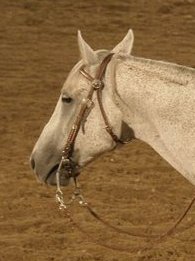 When you’re just buying a horse, or beginning riding a new horse, it can be really hard to know what type of bit to use. There are two ends of the spectrum, where you don’t want to use a bit that is too severe and risk ruining a horse’s mouth, but you also don’t want to use a bit that the horse doesn’t respect at all and risk getting thrown or run away with. So choosing what bit to use for your horse is a very important decision, and I’ll share some tips that might be a help.
When you’re just buying a horse, or beginning riding a new horse, it can be really hard to know what type of bit to use. There are two ends of the spectrum, where you don’t want to use a bit that is too severe and risk ruining a horse’s mouth, but you also don’t want to use a bit that the horse doesn’t respect at all and risk getting thrown or run away with. So choosing what bit to use for your horse is a very important decision, and I’ll share some tips that might be a help.
My brother asked me the other day what kind of bit would be good for his gelding Toby, a ten year old black registered paint horse. Having prior experience with riding this horse, I knew a lot about the horse’s sensitivity and reactions to the bits and headgear I had tried him in. My brother purchased Toby from a woman who was scared to ride him and had him outfitted in a twisted wire snaffle and training fork that forced his head down with each touch of the reins. Toby was a bundle of nerves, spooky, fussy, and actually dangerous to ride. Against my suggestion to find a safer horse, my brother bought the flashy black gelding.
After a year or two in the pasture, Toby came to our place for a training refresher. I saddled him in the round pen and gingerly stepped into the stirrups. He walked around with his head down like an old broke horse. When I put a smooth D-ring snaffle on him, he mouthed the bit crazily and seemed very preoccupied with it. I could ride him in it, but he continually lowered his head to the ground, chomping and trying to push the bit out with his tongue. After a few rides in this fashion (it wasn’t much fun), I tried riding him in my rope halter, looping the lead rope over his neck and tying it again to the halter like reins. He did just great in the halter, and responded well to all my cues.
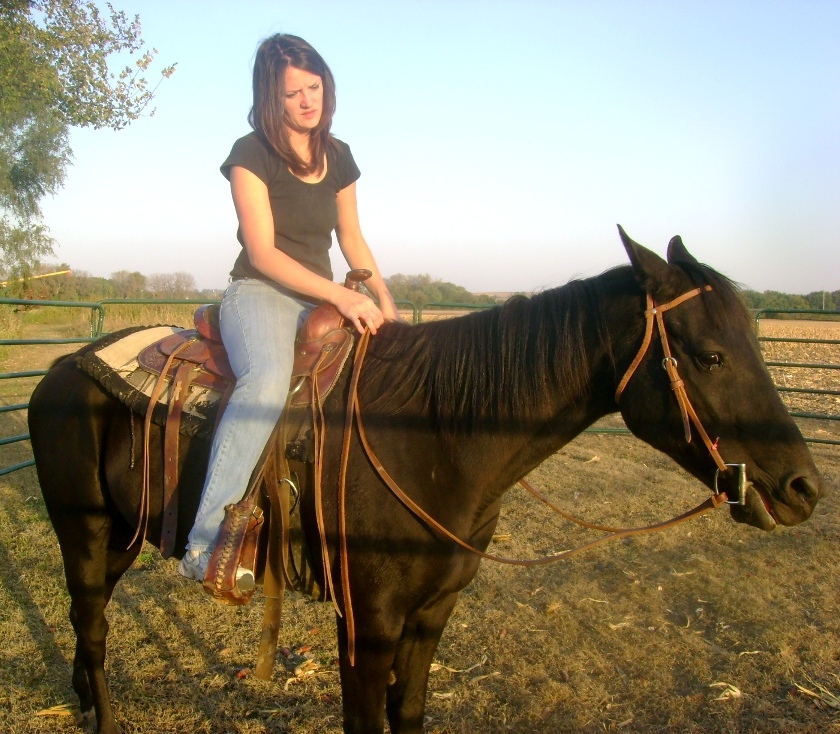 You can see in the above photo how much Toby was hating the bit, and couldn’t concentrate on riding because he was so preoccupied with it. So I deduced that either Toby had teeth problems and needed a vet to look at him, or else he just hated bits and should be ridden bitless the rest of his life. His mouthing wasn’t just the initial stages that most colts go through when you first introduce them to the bit…he was actually chewing it and could not relax with it in his mouth, no matter how much time I gave him to get used to it. So after Toby returned to my brother’s, they had his teeth floated, and his wife has been riding him in a halter. They asked me what kind of bit would be good for Toby, that would provide more control than the halter does.
You can see in the above photo how much Toby was hating the bit, and couldn’t concentrate on riding because he was so preoccupied with it. So I deduced that either Toby had teeth problems and needed a vet to look at him, or else he just hated bits and should be ridden bitless the rest of his life. His mouthing wasn’t just the initial stages that most colts go through when you first introduce them to the bit…he was actually chewing it and could not relax with it in his mouth, no matter how much time I gave him to get used to it. So after Toby returned to my brother’s, they had his teeth floated, and his wife has been riding him in a halter. They asked me what kind of bit would be good for Toby, that would provide more control than the halter does.
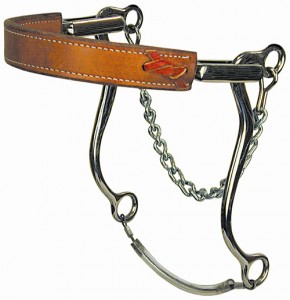 I sent him a link to purchase this hackamore on Horse.com, an online tack store that carries most types of bits and horse tack. My dad is a fan of the mechanical hackamore, and while I have seen some severe ones (I don’t like the rubber coated bike chain version you see once in awhile), the flat leather noseband with medium shanks is a good riding bit for a horse that dislikes a mouthpiece but still needs more control than a halter. The leverage of the shanks makes the chin strap tighten under the horse’s chin, providing a lot of stopping power. With a heavy-handed rider, that much leverage would be too severe, but in good hands, the hackamore is a great bridle to use. My brother said he’ll let me know how Toby likes it. I’m thinking he’ll love anything that doesn’t go in his mouth.
I sent him a link to purchase this hackamore on Horse.com, an online tack store that carries most types of bits and horse tack. My dad is a fan of the mechanical hackamore, and while I have seen some severe ones (I don’t like the rubber coated bike chain version you see once in awhile), the flat leather noseband with medium shanks is a good riding bit for a horse that dislikes a mouthpiece but still needs more control than a halter. The leverage of the shanks makes the chin strap tighten under the horse’s chin, providing a lot of stopping power. With a heavy-handed rider, that much leverage would be too severe, but in good hands, the hackamore is a great bridle to use. My brother said he’ll let me know how Toby likes it. I’m thinking he’ll love anything that doesn’t go in his mouth.
When you purchase a horse that is previously trained and ridden, it is always good to ask what bit the horse is used to being ridden in before you purchase the horse, and watch the horse being ridden before you buy it. The type of bit used can tell you a lot about the horse, as well as about its previous owner. While every bit has a purpose, and some bits are only severe if in the wrong hands, a harsh bit can be an indication of a horse that has bad habits or is unsafe.
I think a good, well-broke riding horse should be able to ride in a variety of bits. For instance, a ranch horse that is used to being neckreined in a curb bit would be expected to perform the same way if it was being ridden in a snaffle bit or hackamore, or whatever. But it’s best to choose a bit that the horse performs well in, and then not change it. Use the mildest bit possible that your horse will be comfortable in and still obey all of your directions. I often hear of people wanting to try a different bit, hoping to solve some problem they have with the horse’s riding…and I usually think that the horse just needs more training and better riding, not a bigger bit.
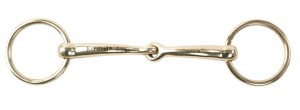 When I’m training a colt, or first starting a horse that I’ve not ridden before and don’t have much history on, I will put them in a plain o-ring snaffle with a thick mouthpiece, because that is the most gentle bit. A colt needs time to get used to the bit and learn to give to the rein pressure and find relief when he obeys. A horse that initially resists the bit or attempts to evade pressure by tossing his head, backing up, or running through the bit should just be given more time and more practice until he learns to respond to the mild pressure of the snaffle bit. So just because a young horse does not respect a mild bit does NOT mean you should change bits and get something stronger–it will only accentuate the problems. Work with the colt to get a softer response by riding with more attentiveness, getting quicker at the release when the colt obeys, and giving the colt time to figure out what you’re asking for. Pushing a horse too quickly through the bitting process will just make him hard-mouthed and sour.
When I’m training a colt, or first starting a horse that I’ve not ridden before and don’t have much history on, I will put them in a plain o-ring snaffle with a thick mouthpiece, because that is the most gentle bit. A colt needs time to get used to the bit and learn to give to the rein pressure and find relief when he obeys. A horse that initially resists the bit or attempts to evade pressure by tossing his head, backing up, or running through the bit should just be given more time and more practice until he learns to respond to the mild pressure of the snaffle bit. So just because a young horse does not respect a mild bit does NOT mean you should change bits and get something stronger–it will only accentuate the problems. Work with the colt to get a softer response by riding with more attentiveness, getting quicker at the release when the colt obeys, and giving the colt time to figure out what you’re asking for. Pushing a horse too quickly through the bitting process will just make him hard-mouthed and sour.
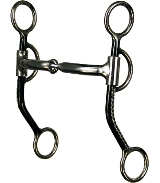 Then after a horse has had some training and is going along well and you’d like to introduce neck reining, you can switch to a bit with a snaffle (jointed) mouthpiece and shanks, as this will encourage the horse to soften in the neck and give with less direct contact on its mouth. I like to use a reining style bit, or an Argentine snaffle, and stay away from the Tom Thumb bit. I grew up using Tom Thumbs because they were the cheapest bit you could buy, but they tend to pinch at the corners and sore a horse’s mouth. I think if your horse works fine in this style of bit, you could use it for the rest of your horse’s life. But if your horse is neck reining well in the shanked snaffle, you can also transition to a curb bit from there.
Then after a horse has had some training and is going along well and you’d like to introduce neck reining, you can switch to a bit with a snaffle (jointed) mouthpiece and shanks, as this will encourage the horse to soften in the neck and give with less direct contact on its mouth. I like to use a reining style bit, or an Argentine snaffle, and stay away from the Tom Thumb bit. I grew up using Tom Thumbs because they were the cheapest bit you could buy, but they tend to pinch at the corners and sore a horse’s mouth. I think if your horse works fine in this style of bit, you could use it for the rest of your horse’s life. But if your horse is neck reining well in the shanked snaffle, you can also transition to a curb bit from there.
A lot of riders prefer bitless training and riding, and that often results in a very nice start for a colt, and keeps a horse’s mouth soft. You can start a colt out in a bosal, which is just a braided rawhide noseband and usually has romal reins or a mecate. This is a very soft way to start a colt, and gives them a very nice headset. Once they get a good response and are consistent in the bosal, you can move up to neckreining with a hackamore and get along just fine without ever having to put anything in your horse’s mouth.
I would like to add that there are hundreds of bit types, and just because I’m suggesting these three doesn’t mean they are a perfect fit for your horse. These are the bits that I use and favor, mainly because I grew up using them and was taught this progression when you are training a colt. But there are other bits that work better for different riders and different horses, and just because you might see someone using a different bit doesn’t mean that it isn’t a good fit for their horse.
I strongly believe that you ought to work with your horse’s preferences as much as possible. If the horse hates the bit, find a way to ride without one. If your horse is throwing his head with the shanked bit, back off to a milder plain ring snaffle. If your horse acts uptight and uncomfortable, make sure you have his teeth checked by a vet, and try a milder bit or hackamore. Just make sure you’re fulfilling your horse’s needs and listening to what he’s trying to tell you.


{ 2 comments }
Great article, Kerrie! I love reading your blog.
Thanks for reading, Lauren. I would love to have your input on the bits you choose for English riding, as that’s a whole different set of bits, and I’d have no idea what to use. I just wanted to share what works for me, but I’d love to hear your viewpoint on good English bits to use!
I would love to have your input on the bits you choose for English riding, as that’s a whole different set of bits, and I’d have no idea what to use. I just wanted to share what works for me, but I’d love to hear your viewpoint on good English bits to use!